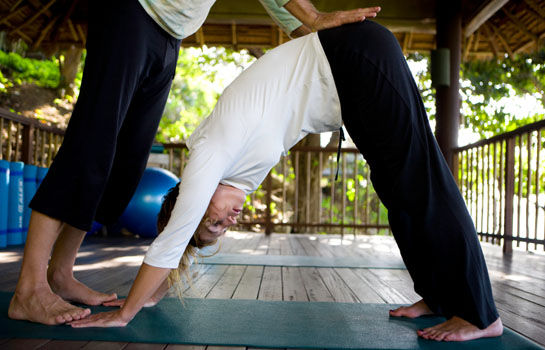 By Megan Senger
By Megan Senger
Several years ago Pam Kamoku was an ACE-certified Personal Trainer with a booming business and an aching back. As was the case with many of her clients, a decades-old sports injury had failed to respond to years of traditional strengthening exercises and diligent fitness workouts.
“The problem with a continued focus on building strength is that, at some point, you start to build tension on top of the strength,” she reflects. For her, the solution was an alternate mind-body niche known as yoga therapy, which has since evolved beyond the remedy for her aching back and into her full-time profession.
Yoga therapy is a specialized practice, distinct from “regular” group yoga classes and complete with its own professional organization, training programs and trade magazines. As its popularity increases, ACE-certified professionals knowledgeable about this practice can boost business through referrals with these specially trained mind-body professionals. It also offers a prospective career pathway for yoga-enthused personal trainers like Kamoku, who is now the owner of Ease in Motion yoga in Maui, Hawaii.
Here’s where this developing profession stands today.
What Is Yoga Therapy?
A yoga therapist is a traditional yoga teacher with extensive additional training to be able to work with clients who have challenging biomechanical or medical conditions with physical and/or mental origins.
Unlike most other fitness professionals, a yoga therapist uses a broad range of mind-body-based healing tools in conjunction with exercise. Peek into a one-on-one session with Kamoku these days and you are just as likely to see her teaching clients to chant or meditate as to strengthen and lengthen their muscles.
A yoga therapist’s toolkit may include:
- physical techniques (e.g., stretching and/or strengthening yoga postures)
- mental training (e.g., breathwork or somatic awareness exercises)
- philosophical practices (e.g., volunteering or donating to others as a form of stress release)
While yoga therapy incorporates physical exercise, it differs from “regular” yoga classes and personal training in the following ways:
It’s individualized. “Yoga therapy is offered one-on-one, to individually tailor a practice to the needs, abilities and goals of a specific individual,” says Carol Krucoff, a yoga therapist, ACE-certified personal trainer and ACE spokesperson in Chapel Hill, N.C.
It’s more than just postures. Well-trained practitioners use many techniques, says Beth Shaw, founder of YogaFit, an ACE educational partner that offers basic yoga training for fitness instructors as well as complete yoga therapy education programs. Techniques that may be used include “breathwork, meditation, chanting, traditional yogic philosophy, movement and more,” notes Shaw.
It’s holistic. “Yoga therapy addresses the person with the condition, and not the condition in isolation,” explains Susi Hately, a prolific author and owner of Functional Synergy, a yoga-therapy school based in Calgary, Alberta. Yoga therapy asks what is going on with a client physically, mentally and emotionally, agrees Shaw.
It goes beyond workouts. “Teaching people how to relax and release tension is a huge part of the yoga therapist’s work,” notes Krucoff. And it’s sometimes more than de-stressing. “Yoga therapy can extend into the spiritual realms as well, such as when a student may be dying of cancer,” adds John Kepner, M.A., M.B.A., a practicing yoga therapist in Little Rock, Ark., and executive director of the International Association of Yoga Therapists.
It’s empowering. “Yoga therapy provides a more engaged way for an individual to actively seek wellness and get at the cause of [his or her] condition rather than be a passive patient in the western medical paradigm,” says Shaw.
A New Industry Niche
Yoga therapy, though still relatively new, is becoming increasingly credible and standardized. “We are at a transition point in the field,” says Shaw, who lives in Los Angeles, Calif. “The standards for education have just been formalized; the field is defining itself and is validating the work with a lot of great research.”
Referring to a Yoga Therapist
Sharing referrals with a yoga therapist presents your clients with broader wellness opportunities and positions you as the fitness expert.
“Personal trainers likely know more about achieving goals such as enhancing muscle strength and cardiovascular endurance,” notes ACE-certified trainer and yoga therapist Carol Krucoff. “However, yoga therapists may know more about achieving goals such as finding peace of mind and coming into a comfortable and compassionate relationship with one’s own body, mind and spirit.”
In this way, a yoga therapist might be particularly able to assist clients whose conditions are best addressed by practices like meditation and breathwork, such as ongoing disease states, terminal illness or acute, debilitating stress.
To find a practitioner in your area, check out the membership directory at IAYT.org.
As with fitness, the trade of yoga therapy is self-regulated. Currently, there are no legal requirements or regulations imposed on the industry or on anyone wishing to call him or herself a yoga therapist, notes Hately.
This self-regulation comes primarily through the method’s trade organization, the International Association of Yoga Therapists (IAYT). Founded in 1989, the 3,000-member-strong non-profit hosts annual conferences and publishes the trade’s magazine, Yoga Therapy Today. It also supports yoga-related research through its peer-reviewed International Journal of Yoga Therapy.
Yoga Therapy Education
Until recently, one of the barriers to using yoga therapy in allopathic medical settings such as hospitals has been a lack of recognizable and credible standards, notes Kepner.
To move the industry forward, IAYT published the first-ever educational guidelines for yoga therapy schools in July 2012—the result of three years of collaborative efforts by leading industry educators. (It is a nod to the interdisciplinary nature of yoga that, in addition to being yoga instructors, much of IAYT’s leadership hold advanced degrees in medical or psychological disciplines.)
IAYT-sanctioned schools must now offer a minimum 800 hours of yoga therapy−specific education, over a two-year period. This time must include at least 150 practicum hours conducted under the supervision of a mentor. Of the 800 hours, 650 must cover IAYT-mandated, competency-driven content, while the remaining 150 hours allow for elective topics, such as special populations or Ayurveda (traditional Indian medicine).
Prerequisite to any yoga therapy−training course is a basic 200-hour yoga instructor’s course (recognized by Yoga Alliance, an international professional organization that provides support services and yoga teacher certification, and is separate from IAYT). The guidelines also require one year of group yoga−teaching experience and one year of personal yoga practice for entry to any IAYT-accredited yoga-therapy program.
The new standards are roughly at the level of a professional master’s degree, notes Kepner. He believes that, while these requirements may seem daunting, they will also raise the demand for, and profile of, yoga therapists. Indeed, besides private yoga schools, some colleges—such as Loyola Marymount University in Los Angeles, Calif.—now offer certificate and even degree programs in the trade.
Yoga Therapy in the Fitness Arena
You may already have a positive working relationship based on mutual referrals with a physical therapist or chiropractor. But cultivating a similar arrangement with a yoga therapist can provide you with both greater credibility and potential customers.

Yoga therapist Hately has built up a referral network with several fitness professionals in her area, who send her clients too ill to start a traditional fitness program. She refers participants back as they regain their health and want to start a gym-based or sports-training program.
“The key here is that none of us can work with everyone,” Hately says. “It is simply not possible. Whether a highly trained yoga therapist or a highly trained personal trainer, we all have our strengths.”
It is important to have a clear understanding of your skills and limitations, urges Haley, and then to find other professionals to assist where you can’t reach. And like trainers, Kepner notes that yoga therapists are trained to refer clients to other skilled psychological, medical and fitness practitioners when needed.
An Evolving Profession
Yoga therapy, while relatively new, is developing rapidly. “When I started with IAYT in 2004, we listed five training programs on our website,” Kepner says. “Now, we list over 90.”
The trade is also poised to impact allopathic medical models. The field is moving to where yoga therapists will be able to someday bill insurance companies for their services, notes Shaw.
But for personal trainer-turned-yoga therapist Pam Kamoku, this new niche offers something more personal—a way to complement her years of experience as a trainer while also helping to decrease clients’ pain.
“Yoga therapy is truly about working with mind, body and spirit,” she says. “It’s not about fixing people, it’s about helping someone with his or her movement and breath and then allowing the healing process to begin. And that’s the whole reason I got into this business.”
____________________________________________________________________

Megan Senger is a writer, speaker and fitness sales consultant. Active in the exercise industry since 1995, she holds a bachelor’s degree in kinesiology and English. When not writing on health and lifestyle trends, techniques and business opportunities for leading trade magazines, she can be found in ardha uttanasana becoming reacquainted with her toes. She can be reached at www.megansenger.com.